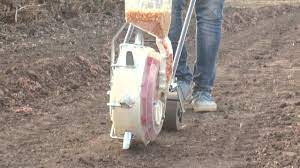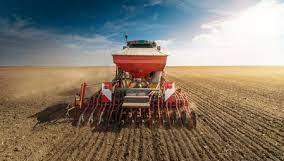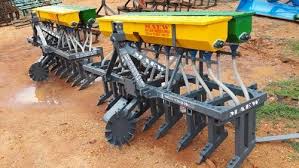SOWING AND METHODS OF SOWING
What is sowing?
Sowing is the process of planting seeds or seedlings in the soil. The proper seeding gives correct amount of seed per unit area, proper depth at which seed is placed in the soil and proper spacing between row-to-row and plant to plant.
In agronomy, generally seeds are sown while, in horticulture, vegetative parts of the plant are planted or propagated.
Methods of sowing
There are different methods of sowing followed after preparation of field.
- Broadcasting- It is the process of random scattering of seed on the surface of seedbeds. When broadcasting is done manually, uniformity of seed placing is not maintained and usually higher seed rate is obtained in this system.
- Dibbling- Dibbling is the process of placing seeds in holes at definite depth and fixed spacing made in seedbed and covering them. This method is also known as line sowing method.
The equipment used is called Dibbler contains a conical instrument used to make proper holes in the field. Small hand dibblers are made with several conical projections made in a frame.

Dibbler This method consumes more time, so it is not suitable for small seeds, but generally used for coarse seeds like maize. Mostly vegetables are sown in this way.
- Sowing seed behind the plough– It is very common method used in villages wherein, a man drops seeds in the furrow behind the plough. Sowing behind the plough can be done by a device known as malobansa. It consists of a bamboo tube provided with a funnel shaped mouth. One man drops the seeds through the funnel and other man handles the plough and the bullocks.
It employs in two ways called Kera and Pora. Kera is a manual method wherein, one man drops the seeds behind the plough. Pora is a mechanical method as seeds are dropped by man through funnel. This is a slow and laborious method. - Drilling– Drilling consists of dropping the seeds in furrow lines in a continuous flow and covering them with soil. Seed metering may be done either manually or mechanically. This method is very helpful in achieving proper depth, proper spacing and proper amount of seed to be sown in the field. In agriculture, most seed is now sown using a seed drill, which offers greater precision; seed is sown evenly and at the desired rate.

Seed drill
Now a days, seed drills are of various types and used for various purposes like fertilizer/herbicides application along with seed sowing.
Seed cum ferti–drill Seed cum Fertilizer Drill- Seed drills fitted with fertilizer dropping attachments are called seed-cum-fertilizer drills; they deliver both the seeds and fertilizers simultaneously in an acceptable pattern. Seed cum fertilizer drill has a large seed box which is divided lengthwise into two compartments, one for seed and another for fertilizers distribution.
- Transplanting– Transplanting consists of preparing seedlings in nursery and then planting these seedlings in the prepared field.It is commonly done for vegetable and flowers commonly known as planting method. Besides, it is also used in paddy crop either manually or through paddy transplanter. Equipment for placing plants in the soil is called transplanter.
- Hill dropping– In this method, seeds is dropped at fixed spacing but not in a continuous stream. Unlike drill, the spacing between plant to plant in a row is constant in this method.
- Check row planting– This method of planting provides uniform row-to-row and plant-to-plant distance. In this method, seeds are planted precisely along straight parallel furrows. The rows are always in two perpendicular directions. The machine used for check row planting is called check row planter.
Read also…
SEED GERMINATION-PROCESS & FACTORS OF GERMINATION
SEED MULTIPLICATION & SEED REPLACEMENT RATIO
SEED CLASSES- TYPE AND FEATURES
TYPES OF SEED- STRUCTURE & FEATURES
SEED DISPERSAL- TYPES AND IMPORTANCE
SEED DORMANCY- DEFINITION, TYPES & IMPORTANCE